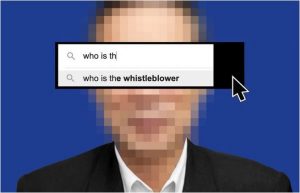
(c) Ant-o-Rama, 2015: Darth Apple Caught Unawares
“The whole purpose of education is to turn mirrors into windows.”
Sidney J. Harris
In our last segment, we grappled with those elements of blindspots that exceed our grasp of our influence as researchers. We looked at our limits of imagination, perspective-taking, and the obstacle of wish-fulfillment as areas in need of greater self-awareness and pro-active monitoring of tendencies that can undermine our effectiveness as researchers. In part two, we explore the more personal level of coming to terms with our blindspots: What that looks like in the context of “business as usual.”
How can can take our own shortcomings on-board? Where does this help us to raise our game as researchers, both in the conducting of our cases and reporting of our findings? What does it mean to become an expert at our own failings?
That too is a mastery over blindspots. One that saves us from repeating the temptation to go it alone when there’s a collaborator who can lead where we will falter.
Flattering Ourselves
Not everyone swipes their badge and descends into their fortified bunker or a fortress dressing up as avatars for a theoretical confrontation. So how do we make this real? How does this play out on a more personal level? More to the point: How do we assess the probability of these imagined events actually visiting us in the future? Are we privileging our own self-importance? Are we inflating the box office appeal of us starring in our own video game cinema? Virtual reality headset not included!
One of the firsthand experiences we all walk away from is the kind we go to great lengths not to experience again. That sense of dread and avoidance at-all-costs comes from events we consider beyond our control, even our comprehension. We know where to find our personal shutoff valves. We know where to run for safety, to wrestle back control from a daunting adversary, or the chaos that sends us fleeing its crushing, oversized footprints.
But what happens when these grim outcomes are in reach and we’re the last to know? What happens when we’re oblivious to these looming dangers, until the menace is upon us? Our lack of awareness and preparedness can amplify the pain. There’s no hunkering down or shelter to seek when the moment of dread arrives arm-and-arm with our own ignorance (and search history). There is no transitional period from the blow to the head to crashing said head to the hard, frosty floor.
Coming to Blows With Our Demons
It’s not just cushioning the blow that should concern us. It’s the gnawing realization that the factors leading to this sneak attack were conspiring in broad daylight right under our congested sniffers. We can’t blow the cover of every closed door meeting. The challenge is for our dismay to move beyond our wounded pride to a front row seat of our own gullible, unsuspecting nature. That’s the show worth watching long after the element of surprise recedes.Confronting one’s vulnerabilities benefits us in two ways as researchers:
1. A wider recognition of our personal blindspots
2. An enhanced appreciation for the people we investigate
These sobering and ultimately enriching lessons carries us beyond the limitations of our own risk avoidance. It moves us past the shortness of breath and imagination that comes with being spooked. It elevates us beyond our own instincts for self-preservation and summons powers normally associated with superheroes. We can walk through the walls of closed door meetings. We can better handle the aggressive language of the alleged suspects in their defensive crouches. We sidestep the familiarity traps that befall the prisoners of self-imposed comfort zones.
As outsiders, we’re less prone to the rising pressure of maintaining a code of silence. We are not looking the other way but that doesn’t mean we compromise a confidence; not when there may be more to see. As fluency learners, we’re not staked to unassailable positions, sacred cow sources, or the close-ended commitments of sunk costs and confirmation bias. Not having an airtight narrative doesn’t put us on shaky ground. Neither does losing our earlier assumptions when they don’t match the surprising evidence we gather.
Taking One for the Project

Another burden worth shedding is that successful investigations ride on the shoulders of the investigator. Admissions of fault or confessions to a deeper truth are not tests of our will or diplomacy skills. Many times these breakthroughs are measured as much by the emotional distance the witness or whistleblower opens between themselves and the wrath of the person or group they’re implicating:The further the distance, the more forceful the allegation.
These dynamics don’t play-out on their own. They require the perspective-taking of the investigator to determine the psychological distance between case informants and their respective risk profiles. Has enough time expired tore-approach a long-buried secret? Have the sparring fighters returned to their ringside corners? Enough airing of past differences to have ironed them out?
There are countless back stories that relative newcomers stumble into; unsettled scores cloaked behind the territorial claims of entrenched adversaries. A learner’s mind is an inquiring one outside the safety of established social circles and affirming peer groups. Newcomer over-confidence in one’s abilities to hear and speak like a native? That’s a blindspot unique to investigators.
An ego can be a heavy thing to carry around. Fortunately we only have to carry one of those at a time (being a parent notwithstanding!) However, you get the unfiltered glimpse of the onlooker when you lower the barricades around the locked-down neighborhoods where your pride is patrolling. The spectator figures who form the optics of how that hot, inflamed blindspot looks to others in the cold light of day.
There’s humility for starters. Is a co-worker fibbing when they over-apologize forcoming late to a meeting? Perhaps I too can recollect not sharing a key reason why I was the one late to the last call? Is that target on my back etched in my own handiwork? Did I unwittingly tamper with the holy grail of someone else’slost horizon? Am I culpable, guilty as charged? Does my own gullible nature testify to my innocence? Can both conclusions be drawn from the conflicting parties impacted by my research?
More Scratches Below the Surface
Besides our clumsy, fragile egos, another obstacle worth kicking out from under us is this notion of control. We leave the stage managing to the attorneys and production crews. But for investigators the action falls into line with two paths to discovery: guided and unguided questions. Guided questions have hard stops, pre-determined assumptions, and a bias towards binary yes/no answers. Unguided questions give the respondent more interpretive leeway. Given enough discretion, they can even reframe the question.
Put another way, guided questions are the ones we want to answer. Unguided are those our targets want to address. Confusing the two and you’re splintering a blindspot through all manner of observing lenses: spyglasses, binoculars, microscopes, drone cams … to name a few. In fact, our guided questions are unmasked invitations to theories and speculations that our targets know to be tenuous, contestable, even flat-out wrong, and insulting.
Why would the interrogated dignify a misguided question premised on the interrogator’s foregone conclusion? Another reason to tread lightly through the signals we investigators strike. The imaginations we fire. The burden of those loaded questions we carry. Is the evidence conclusive? Or do the loose-ends stray from our theories of the case?
“The whole truth” is the sworn testimony we commit to upholding in our legal oath as trial witnesses. The more versions to consider, the more pronounced the role of blindspots as the obstruction to this clarified, verifiable and binding view of conflict resolution. We investigators need to address our own culpability as direct participants in the legal processing of justice before we can permeate the blindspots that cloud the periphery of all containable truths.
Editor’s Note – This article republished with the author’s permission – first publication on his blog Searching Out Loud.
